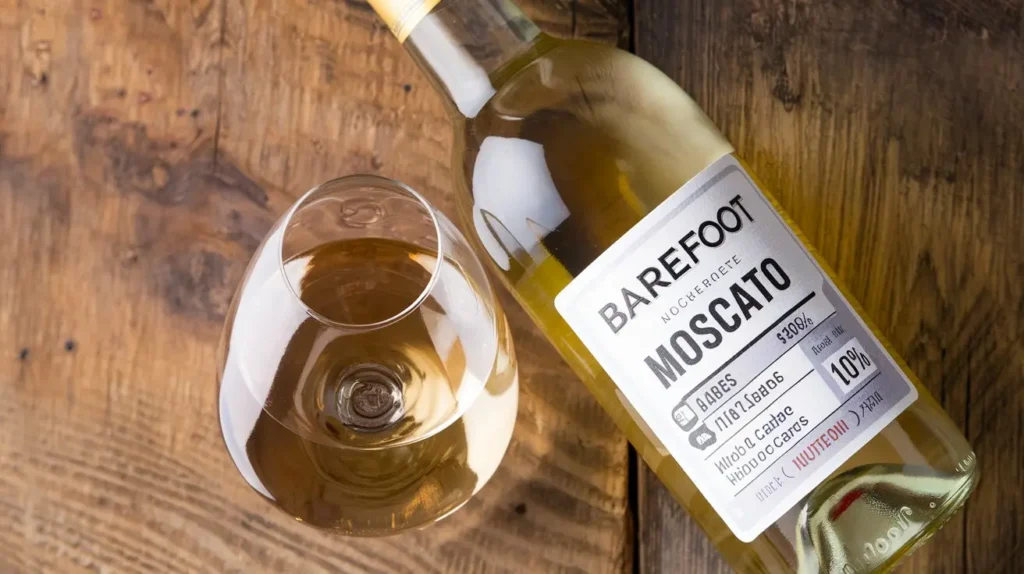Barefoot Moscato is a popular sweet wine that many enjoy for its fruity flavor and light body. But if you’re mindful of what you consume, it’s important to know the nutrition facts of the drinks you enjoy. This article will break down the key nutritional details of Barefoot Moscato, helping you understand its content and how it fits into your diet.
Overview of Barefoot Moscato
Barefoot Moscato is a light, semi-sweet white wine produced by Barefoot Cellars. It’s made from the Muscat grape, which is known for its sweet, fruity, and floral flavors. This wine is often enjoyed on its own or paired with desserts, light salads, and fruit.
While many drink wine for its taste and relaxing effects, there are other factors to consider—such as calories, carbohydrates, sugar content, and alcohol percentage. Understanding these aspects will help you make informed choices about your consumption.
Calories in Barefoot Moscato
Calories are a primary consideration for those watching their diet. Barefoot Moscato, like many wines, contains calories primarily from alcohol and sugar. A standard serving size of wine is 5 ounces.
- Calories per 5 oz. serving: On average, Barefoot Moscato contains about 127 calories per 5-ounce serving.
If you’re watching your calorie intake, it’s important to note that drinking more than one glass can quickly add up. For example, two glasses would contain about 254 calories, which is comparable to the calories in a small meal.
Carbohydrates in Barefoot Moscato
Carbohydrates are another important nutritional aspect to consider, especially for those following low-carb or keto diets. The carbohydrates in wine mainly come from the residual sugars left after fermentation.
- Carbs per 5 oz. serving: Barefoot Moscato contains approximately 11 grams of carbohydrates per 5-ounce serving.
Most of these carbs come from sugar, as Moscato is known for being a sweet wine. If you’re monitoring your carb intake, this may be something to keep in mind.
Sugar Content in Barefoot Moscato
Sugar content in wine varies depending on the type of wine and how it’s produced. Moscato, being a sweeter wine, tends to have a higher sugar content than dry wines.
- Sugar per 5 oz. serving: Barefoot Moscato contains about 8 grams of sugar per 5-ounce serving.
For comparison, this is higher than a typical dry wine, which usually contains about 1 to 2 grams of sugar per serving. If you’re cutting back on sugar, it’s worth considering how this fits into your daily intake.
Alcohol Content in Barefoot Moscato
The alcohol content in wine plays a role in both its taste and calorie content. Wines with higher alcohol content generally have more calories because alcohol itself contains calories.
- Alcohol by Volume (ABV): Barefoot Moscato has an ABV of about 9%.
This lower alcohol percentage is part of what gives Moscato its light and easy-to-drink character. It also means that you’re consuming fewer calories from alcohol compared to wines with higher ABV levels.
Nutritional Breakdown for a 5 oz. Serving
Let’s summarize the basic nutritional facts for a standard 5-ounce serving of Barefoot Moscato:
- Calories: 127
- Carbohydrates: 11 grams
- Sugar: 8 grams
- Alcohol: 9% ABV
These figures are based on a typical serving size. If you drink more or less, you’ll need to adjust the nutritional information accordingly.
Health Considerations
Wine can offer some health benefits, but it also comes with potential downsides. Let’s explore the pros and cons.
Potential Benefits of Drinking Wine
Moderate wine consumption has been linked to certain health benefits, primarily due to compounds like antioxidants and polyphenols. Red wine, in particular, is often noted for its resveratrol content, which may promote heart health. However, white wine like Moscato also contains some antioxidants.
- Heart Health: Moderate wine consumption (1 glass per day for women and 2 for men) may support heart health by improving cholesterol levels and reducing the risk of heart disease.
- Relaxation and Stress Relief: Wine is known to help people unwind after a long day, which may reduce stress and improve mental well-being.
Downsides of Drinking Sweet Wine
While there are benefits, it’s important to consider the downsides as well.
- Sugar Content: The higher sugar content in Moscato compared to other wines may be a concern for those monitoring their sugar intake. Excess sugar can lead to weight gain and increase the risk of conditions like diabetes.
- Calories: Like any alcoholic beverage, wine contains empty calories that provide little nutritional value. Consuming too many calories from wine without balancing your diet could lead to weight gain.
- Overconsumption: Drinking too much wine can lead to alcohol dependence and liver issues over time. It’s important to consume alcohol in moderation.
How Barefoot Moscato Fits into a Balanced Diet
Moderation is key when incorporating wine into a balanced diet. If you’re enjoying Barefoot Moscato, it can fit into most diets as long as you keep an eye on portion sizes and avoid overindulgence.
- Portion Control: Stick to a standard 5-ounce serving to keep calorie and sugar intake in check.
- Pairing with Food: Pair Barefoot Moscato with healthy foods like salads, fruits, or lean proteins to create a more balanced meal.
- Limit Sugary Snacks: Since Moscato is already sweet, it’s best to avoid pairing it with sugary desserts if you’re trying to reduce sugar intake.
Comparing Barefoot Moscato to Other Wines
When choosing wine, you may want to compare Barefoot Moscato to other types of wine based on your dietary needs.
- Dry Wines: Dry white wines like Sauvignon Blanc or Chardonnay have fewer carbs and sugar than Moscato. They typically contain about 3-4 grams of carbs and 1-2 grams of sugar per serving.
- Red Wines: Red wines like Cabernet Sauvignon or Pinot Noir generally have a slightly higher calorie content but lower sugar content compared to Moscato. They also offer more antioxidants due to the grape skins being used in production.
- Sparkling Wines: Some sparkling wines, such as Brut Champagne, are lower in sugar and carbs than Moscato, making them a good choice for those looking to cut back on sugar.
Tips for Reducing Calorie and Sugar Intake While Drinking Wine
If you’re concerned about the calorie and sugar content in Barefoot Moscato, here are a few tips to help you enjoy wine without overindulging.
- Drink Smaller Portions: Instead of pouring a full 5-ounce glass, try drinking a smaller 3-ounce serving.
- Dilute with Sparkling Water: Make a spritzer by adding sparkling water to your wine, which can cut the alcohol, calories, and sugar per glass.
- Alternate with Water: Drink a glass of water between each glass of wine to slow down your consumption and stay hydrated.
- Limit Wine to Special Occasions: Instead of drinking wine daily, save it for special occasions or weekends to reduce your overall intake.
Conclusion
Barefoot Moscato is a delicious and popular wine that many enjoy for its sweetness and fruity flavor. However, it does contain more sugar and calories than some other types of wine. By understanding the nutritional facts of Barefoot Moscato, you can make more informed choices about how it fits into your diet.
To summarize, a 5-ounce serving of Barefoot Moscato contains about 127 calories, 11 grams of carbohydrates, and 8 grams of sugar, with an alcohol content of 9% ABV. While it can be part of a balanced diet when consumed in moderation, it’s essential to be mindful of portion sizes and overall consumption to avoid excess calories and sugar.
Whether you’re enjoying a glass at dinner or celebrating a special occasion, knowing these facts will help you enjoy Barefoot Moscato responsibly and with awareness.



